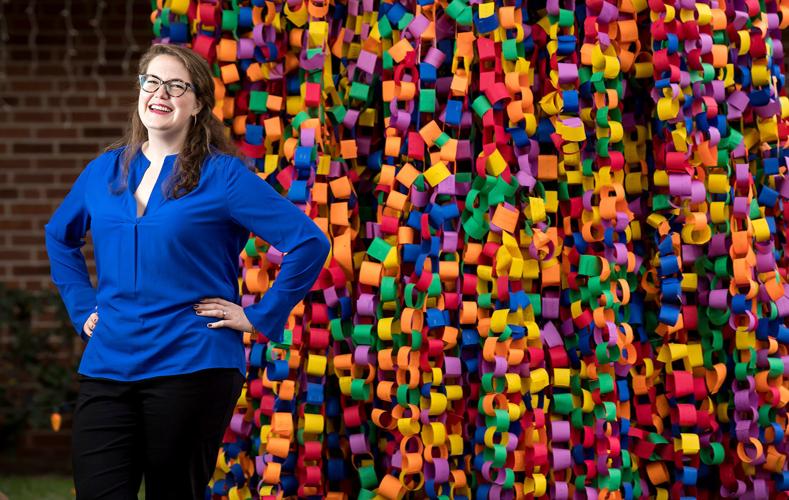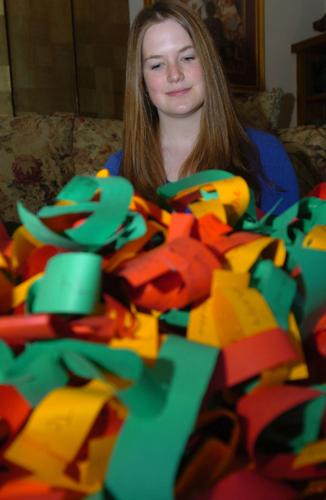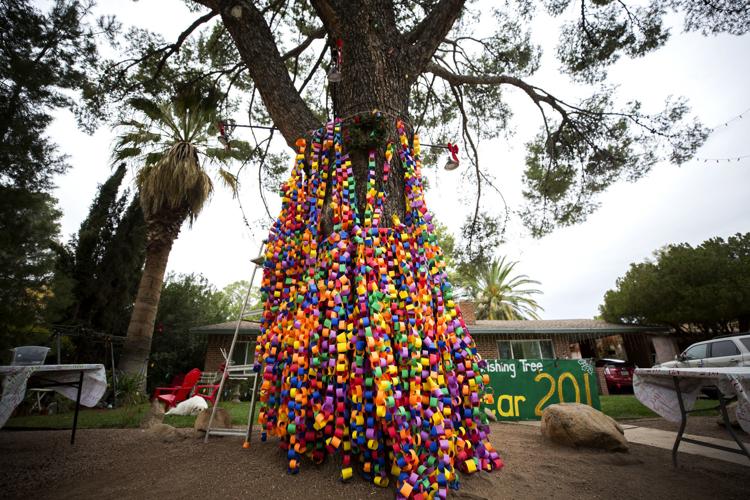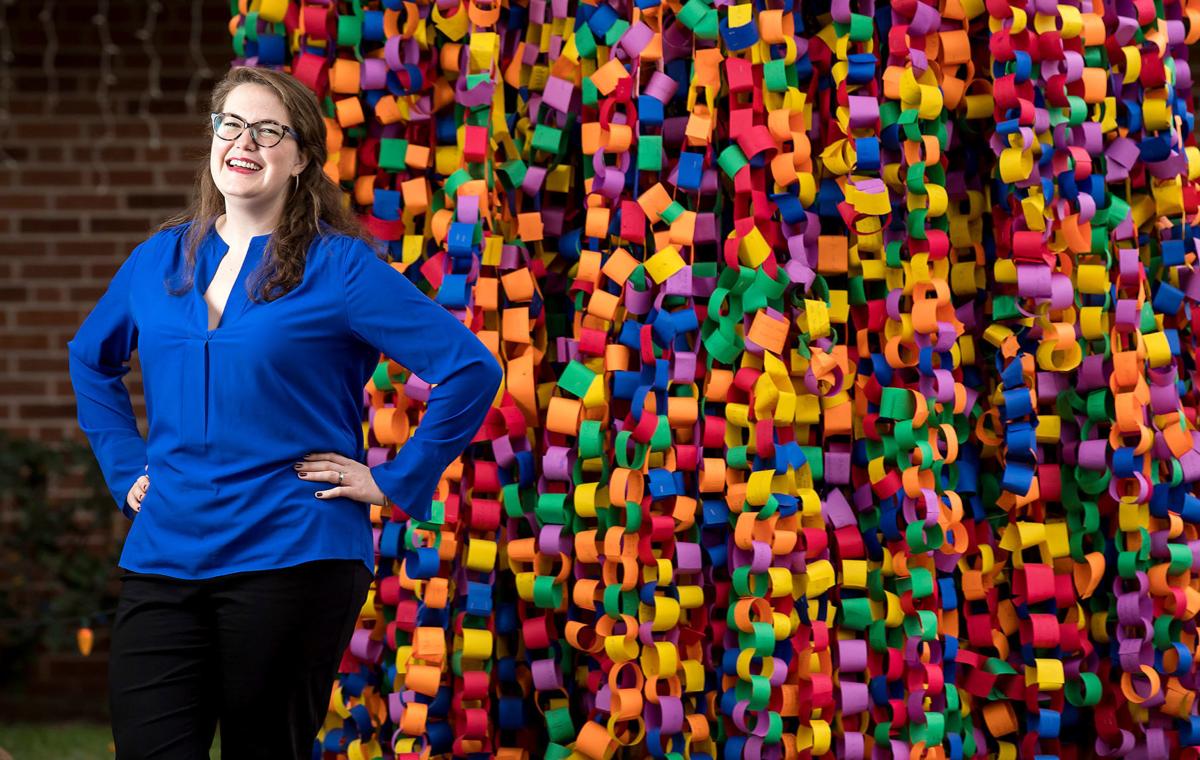Editor's note: This story was first published in 2019, after Liz Baker-Bowman told a version of it at the Arizona Daily Star's Tucson Storytellers "Holiday Stories" event. We're republishing this story in 2024 to let curious readers know what The Wishing Tree, which is up for another year at the Winterhaven Festival of Lights, is all about.
I live on Christmas Avenue.
Yes, Christmas.
It’s in Winterhaven, you know, the neighborhood with all the big trees and holiday lights?
Once I tell people that, I invariably hear:
“Wow, what is it like living there? It must be a nightmare!”
Or, “How magical! What a wonderful place to grow up!”
Or, “Yikes, aren’t you required to decorate?”
But most of all, I hear: “My family goes every year, it’s our tradition.”
I am a third-generation Winterhaven resident.
At one point in my life, my family occupied four homes — all within a block of each other.
It was a lot. But it was also bliss for a child of divorce who just wanted everything to be whole again, and for everyone to be happy.
The best part of growing up in Winterhaven was Christmas.
As a child, I loved going to the opening ceremonies for the two-week Festival of Lights.
Like all the Whos in Whoville, our whole neighborhood gathers around a central tree and sings.
And when the magic moment is right, the tree illuminates.
Santa makes a grand entrance in his sleigh, with a bag full of candy canes for all those who believe.
I believed.
Exhausted with excitement — and snug in bed — I’d fall to sleep listening to the trip-trop of horse hooves with the jingle of their bells, comforted with the knowledge that all of the magic out there would be there waiting for me the next day.
As an adult, that magic is still there, it just looks different.
Now there are hayrides pulled by Jeeps instead of horses.
And the lush green grass I used to roll in now seems pretty non-ecofriendly.
Not to mention that you are basically held hostage in your own house for two weeks.
But there is one thing that sparks the holiday magic, and my hope for humanity each year: The Wishing Tree.
Let’s see if this sounds familiar: “Step One: Take a paper. Step two: Take a pen. Step three: Write your wish.”
That’s my family’s house.
And what was once our tree now it belongs to all of Tucson.
Maybe you are one of the 20,000 visitors who come each year. If not, you are welcome to come help us celebrate this year.
This is the 20th year of our tree gathering the hopes, dreams and desires of our community.
And it all began in the year 2000 with a science fair project.
I was in seventh grade and was already totally into doing scientific research and competing in the SARSEF Science and Engineering Fair. I had four wins under my belt and had studied bugs, art, photography and humans making fools of themselves at the zoo.
I had planned to do another project on animals when I began to hear a trend in the news about the rise of materialism in the new millennium.
The year 2000 was the dawning of the Me Generation.
News outlets shouted: “Consumerism is king!”
Well, given the utopic description of the place I grew up, I am sure you aren’t surprised that this came as a shock to 12-year-old me.
What you don’t know is that I was surviving several kinds of abuse, attended some “tough” schools, and was battling depression and anxiety.
Even still, I knew these adults were wrong.
People are inherently good.
And so I set out to prove it.
Thus, the wishing tree was born.
It was simple. I set out a table, pens, staplers and paper and left the instructions, “write your wish.”
And walked away.
You see, it had to be anonymous.
I knew that if I surveyed people their answers would be different because they would know someone was reading them.
After the two-week festival was over, I took down the wishes and put them in a large black garbage bag for safekeeping.
Each night I’d pull a few out and begin to type.
Between my family and I, we were able to get all 2,731 wishes typed into a spreadsheet.
And then I classified each one.
The results: 73% of the wishes were non-materialistic.
I was RIGHT!
People wished for others far more than they wished for themselves.
And the Top 5 most popular wishes were for: peace, love, happiness, health and to have a merry Christmas.
Sounds like people are pretty good to me.
When I took my project to the science fair, I had no idea what was coming.

Liz Baker, then a senior at University High School, collected six years’ worth of wishes and tabulated them for a science fair project in 2006. The project created a stir.
Adults standing in front of my board were sobbing, reading the book of wishes.
So many were elated by all of the reasons for hope. So many were devastated by the sorrow and pain of the wishes.
All knew they were reading raw, human truth.
The project created a stir. I won. A lot.
It got me in to the Top 40 winners who competed at the national science fair in Washington, D.C. It left such an impression on that group that two years later I was asked to represent the U.S. in a scientific delegation to China.
After all of the hype and publicity that first year, it seemed wrong not to have the tree set up again. After all, 9/11 had just happened and people needed a reason to hope.
And so the tree kept going — and growing.
By the time my senior year in high school came around, I realized I had six years of data waiting to be analyzed, and dozens of black garbage bags.
After all, I couldn’t possibly let my parents throw all of that raw data away.
I recruited friends and family, as well as translators, to help me type up the 25,000 wishes we had accumulated.
The wishes changed through the years.
The hottest toys were cataloged as Razor scooters, PS2s, and the new iPod trended.
World events were captured as people wished for their safety after 9/11, loved ones to come back from Afghanistan, relief for those affected by Hurricane Katrina, and aid for the victims of the deadly 2004 Indonesian tsunami.
Six years were encapsulated in paper chains.
And when the word got out, just like that, a science project became a tradition, and transformed into a Tucson legend.
Now when we walk through the neighborhood on holiday nights, we hear passersby say “Did you know The Wishing Tree is the oldest tree in Tucson?”
(Just so you know it’s not, but try to let the non-dendrochronologists down easy.) People remark, “Wonder what they do with all those wishes.”
With that, my stepfather gives me a knowing look and rolls his eyes. His attic is full, as are all sheds, and a few closets — because even after 20 years, we have kept every single wish.
And it has not been easy.
While I left for college, grad school, and now am in my adult life, my family members are the ones who run out at the first sign of rain to Saran wrap the tree — saving the wishes from water damage.
They took over cutting strips of paper until their arms ached to prepare for visitors each night.
They go out and check the buckets every hour to be sure that there are enough pens and paper, and have perfected the art of unjamming staplers.
Each night after the crowd dies down, around midnight, they go out and clean up the trash left behind.
They are the guardians of the tree.
Why keep it up if it is so much work? Because of the stories. I’ll share just a few.
One of my favorites happened earlier on.

The Wishing Tree is a popular community tradition over the Christmas holiday. “It is so nice to read a story with a positive ending within our city,” a letter writer says of a Dec. 24, 2019 article written by Liz Baker-Bowman.
There was a knock on our door. A young man said he had come to confess a crime — he had stolen a wish.
He explained that he had come to the tree with his girlfriend two weeks earlier and had seen his girlfriend write, “I wish my boyfriend would propose to me.”
At midnight he snuck back into the neighborhood to retrieve it, which took hours of searching ... only to wrap it around the engagement ring he presented to her on Christmas morning.
He and his now fiancée were returning the wish back to the tree.
The following year we attended their wedding. The year after that their baby shower ... and over 10 years later they still stop by each year.
Now there are actual proposals under the tree each year — and last year — even a wedding!
Another year, there was pounding on our door.
We figured it was probably another desperate parent with a kid who had to use the restroom. We were surprised to see a woman was bundled in a large overcoat, and a young man began to speak.
They had come to the tree last Christmas.
For years they had tried everything to become pregnant, and nothing seemed to work. At her doctor’s appointment before they came, they found a small cancerous mass on her ovary. She was scheduled for a full hysterectomy just to be safe.
The man’s wish that year was simple — “Let my wife live.”
But she had to make the wish anyway — her deepest wish — “A baby, please.”
The young man described the day of her surgery — holding his wife’s hand and sobbing over the lost opportunities and fear of losing her. As he sat, ready for the long wait, he was terrified to see the doctor coming back only 30 minutes later — crying. He delivered the news ... “Your wife, she’s pregnant!”
At that point, the young woman opened her coat to reveal the baby hidden from the cold underneath.
The surgery for the cancer waited until after the baby arrived.
Some wishes are shorter in the telling ... and not always as happy.
“I wish my dad would stop kicking my dog when he is mad.”
“I wish for food for my little brother.”
“I wish I could get my kids out of CPS custody.”
“I wish I could get in to that HOT girl’s pants.”
But then there are some amusing ones, like the 5-year-old who wrote, “I wish for cheese!”
And there are so, so many more.
On Saturday, I stood out in front of the tree with my family — admiring the almost blank canvas that would soon become covered. Every year we are the first wishes that start the chains — the links that will support thousands and thousands of others.
I feel optimistic as I pat the tree, knowing how many children with faces screwed up in concentration will scrawl their Christmas wish, how many teens will tease and mock each other and then grow quiet as they write down their heart’s desire, and how many adults will stand at the tree, reflecting on all that they have in the world, and pausing to think about what it really needs.
There have been many points in my life when I have lost faith in humanity, whether it be a current event or a personal crisis.
But I remember the tree, remember that it is backed in research as well as story — and take a deep breath.
There is always hope.
The Wishing Tree is a beautiful mixture of science and magic.
A child’s curiosity allowing others to be vulnerable, and that vulnerability leading to action.
People stand at the tree, sometimes for hours, just reading, reading, reading.
And so that is why I risk skewing my data when I ask you to think carefully before making your wish, because you never know who it will inspire. And who knows, it might just come true.







